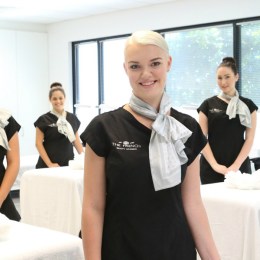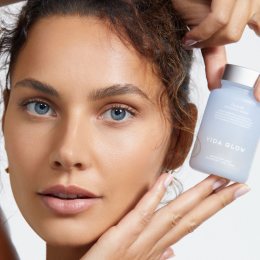DMK Founder Danné Montague King explains the latest release from the innovative skincare line and how it changes the game of treating and improving chronic and acute skin conditions.
Few names resonate as profoundly as Danné Montague King, the visionary founder behind the illustrious DMK skincare line. We exclusively sat down with Danné to discuss his most recent venture, revolutionising the skin treatment game with the latest release of “StemZyme”.


What inspired you to come up with the concept of StemZyme and how long have you been working on it?
Creating StemZyme took me about six or seven years of dedicated work. Unlike many companies that brainstorm products in board meetings just to capitalise on popular buzzwords, I never approached product development that way.
In the early years of DMK Australia, Debbie and Daniel Dickson were tasked with creating new treatment approaches and protocols, not just churning out products for the sake of sales. It was crucial to me that our focus remained on innovation and genuine impact.
StemZyme, in particular, emerged from my frustration with the misinformation surrounding stem cells in the beauty industry. There were claims about plant stem cells and even human stem cells in creams, which not only raised legal issues but were scientifically unfounded.
In discussions with Dr Jayant Lokhande, whom we recently hired and proved to be an invaluable addition, the idea of using our own stem cells for skin cell regeneration emerged. While traditional methods like aspirating stem cells from the hip bone marrow proved impractical for skin regeneration, a breakthrough came when considering vellus hair follicles.
Every person, regardless of gender, has vellus hair all over their face, indicating the presence of stem cells. Extracting these cells, overcoming mitotic shock, and guiding them onto a new genomic pathway became the foundation of StemZyme.

The process involves a meticulous 50-day regimen, but the results are promising. The tissue gains turgidity, underlying firmness, and an unexpected ongoing improvement in the weeks following the treatment. The challenge, however, lies in the unprecedented nature of the procedure, requiring compliance throughout the 50 days.
Despite the high cost and uncertainty, we conducted thorough medical trials before launching StemZyme. The success has been phenomenal, defying replication by other companies that might prioritise the bottom line over groundbreaking innovation.
StemZyme might not be a flashy, instant transformation product like some of our others, but I believe it holds the potential to become the underlying foundation treatment for all DMK.
It addresses not only the signs of aging but also unforeseen issues like hyperpigmentation and acne. While its prosthetic effects on aging remain to be fully understood, I see it as a long-term investment in skin health and regeneration that sets DMK apart from the rest.
Stem cell technology has been a buzzword for a few years. How does StemZyme differ from other stem cell products on the market?
StemZyme stands out significantly from other stem cell products on the market due to its unique approach and the scientific principles guiding its development.
Unlike many products that merely incorporate the term “stem cells” for marketing purposes, StemZyme’s distinction lies in its genuine use of a person’s own stem cells for skin regeneration. So essentially it’s because we’re using our own adult stem cells. Full stop. That’s it.
How does the treatment fit into existing DMK skin clinics?
In the realm of skincare, the concept of “closing gaps” is often thrown around, but StemZyme goes beyond that rhetoric. It doesn’t just fill a hypothetical gap; it fundamentally transforms the skin’s structures, ushering in new cell activity that significantly slows down the aging process.
It’s not merely cosmetic; it’s a genuine shift at the cellular level.

Is it suitable for any skin type and skin concern?
First and foremost, let’s debunk the idea of “skin type.” In today’s interconnected world, with people blending and marrying across diverse racial backgrounds, the notion of distinct skin types becomes obsolete.
The global population is increasingly diverse, making it challenging to categorise individuals based on traditional racial characteristics. Instead, we should focus on skin conditions, and StemZyme proves to be versatile in addressing various skin conditions.
One remarkable aspect of StemZyme is its suitability for any skin condition. It doesn’t exacerbate existing conditions; in fact, it appears to have a harmonising effect. Consider this: new stem cells from your own skin are differentiating into daughter stem cells, maintaining the skin’s homeostasis.
This means that any inflammatory invaders, viruses, or even, in the case of rosacea, parasites, would be naturally repelled. Homeostasis implies a robust defence mechanism, providing a full and natural protection.

In addition to the inherent defence of StemZyme, we also have other protective measures like beta gel. With these tools in place, there’s no reason for anyone to endure the challenges posed by skin anomalies.
StemZyme, by fostering skin homeostasis, offers a comprehensive solution that goes beyond traditional notions of skin types. It’s a testament to the adaptability and effectiveness of the product in the face of the diverse and dynamic nature of modern skin conditions.
Are there any risks involved with StemZyme?
To date we have not encountered any significant issues. Take one of my LA clients, for example. She prefers a porcelain-pale complexion, and she called me up on the third day after applying the serums.
She jokingly said, “I look like a sun-kissed fisherman,” attributing it to the botanical ingredients. There’s a subtle browning effect, but it’s really not a big deal. In the grand scheme of things, it’s a minor consideration.
Are the results comparable to any other intensive treatments?
A lot of ‘invasive’ approaches seem excessively harsh to me. When it comes to lasers, the only one that seemed to have any real impact was the Co2 laser used by plastic surgeons.
However, it essentially vaporised the epidermis, which, while more controlled than old-fashioned medical peels, still resulted in a defence mechanism from the skin — looking waxy, strange, devoid of pigmentation, and not suitable for people of colour. It’s not a favourable comparison.
As for microneedling, it involves blindly sticking pins into the skin, a process that can lead to granulomas — little nodules of scar tissue and adhesion that form when the skin is attacked at a specific point.
While it’s claimed to increase collagen, I’ve witnessed it causing permanent cysts through the disruption of the skin’s natural rhythm of cell development. It’s not something I endorse, but therapists tend to buy into it, thinking it elevates their status.

I’ve stopped actively discouraging it, recognising that therapists will proceed with these methods anyway. However, it still strikes me as barbaric and injurious.
In comparison, what we offer is far superior. I’m not just saying that casually; it genuinely aligns with the natural behaviour of our skin, reminiscent of our youth.
Other methods, in essence, are aggressive attacks on the skin, and any temporary results achieved during the healing phase often lead to worsened conditions in the long run.
We’ve incorporated protocols that work alongside microdermabrasion and similar treatments. I had to accept that people would adopt these machines regardless, so at least we aim to minimise the damage they might cause.
For more information, visit dmkskin.com.au
Read the latest issue of SPA+CLINIC below:
There are 5 ways you can catch up with SPA+CLINIC
- Our quarterly print magazine, delivered to your door. Subscribe here.
- Our website, which is updated daily with its own completely unique content and breaking news.
- Our weekly newsletter – free to your inbox! Subscribe here.
- Our digital magazine – click here to view previous issues.
- Our social media – see daily updates on our Instagram, Facebook & Linkedin




